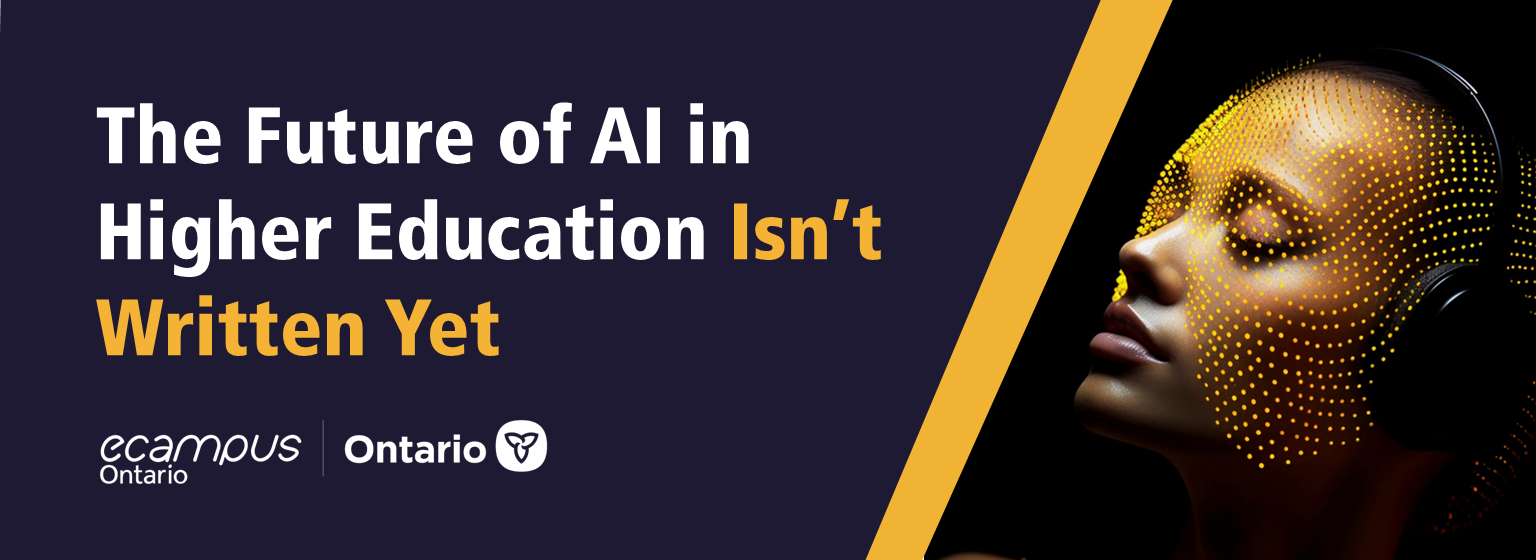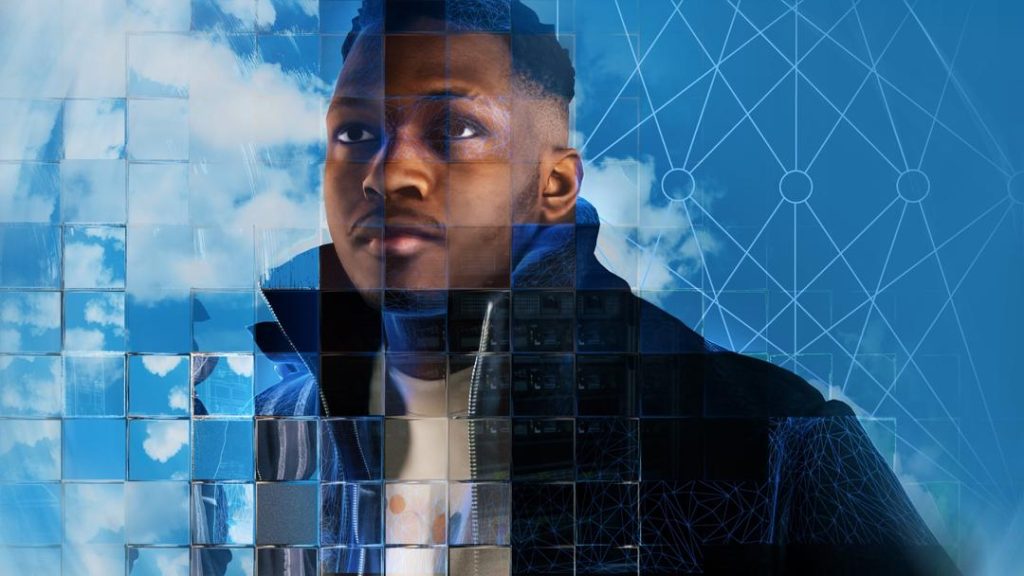
The Future of AI in Higher Education Isn’t Written Yet
Iris Elliott, Associate, Research and Foresight, eCampusOntario
The dominant narrative around artificial intelligence (AI) today is one of inevitability: AI is coming fast, and there is no stopping it. But this framing, while urgent, is incomplete. It flattens the future into a single trajectory, making it feel like the future is a single predetermined path that we are traveling down with no ability to shape what comes next.
At the same time, higher education is facing its own crises. Austerity, questions about relevance, and clarity of role have left many institutions struggling to adapt. In this context, AI can feel like just another setback, another force of disruption that higher education is unprepared to meet.
But this article is about agency.
Even if we assume that AI becomes ubiquitous in the future, there is still a wide range of possible futures that might unfold, and the probability and unfolding of these are being fiercely debated by subject matter experts right now. From OECD [1], to Convergence Analysis [2], to Geoffrey Hinton’s public lectures [3], the conversation is alive with tension and possibility. It is agreed that the promises of AI are vast: improved health, personalized education, enhanced productivity; but so are the questions: How will AI affect jobs? What will happen if AI becomes super powerful? What will higher education’s role be?
Also trying to empower listeners, the OECD shared three different ways that an AI integrated future could unfold:
- AI as a luxury: only available to the privileged few.
- Human interaction becomes a luxury: as AI saturates every layer of life.
- AI’s current trajectory collapses: due to ethical failures, misinformation, or environmental cost.
To these we add a fourth: AI as a shepherd. This is where intelligent systems guide individuals through personalized pathways through learning, work and life. This vision was articulated during the 2024 Micro-credential Forum session between Dr. Robert Luke and Hamoon Ekhtiari of FutureFitAI [4].
How can we empower the institutions, and individuals within them to help shape the future, rather than watching from the sidelines? What are the tools we need to find our levers to imagine ourselves with agency into futures that include what we want to do AND a fully integrated AI?
Anthropologist Dr. Genevieve Bell [5] reminds us that AI is not just a technology. She encourages us to explore the tacit values of AI by prefixing it with adjectives and treating these as a test mirror for values. This reflection of ourselves and AI can help us figure out how we might want to use AI.
This is where eCampusOntario knows foresight can help.
Exploring a range of possible futures can help us see our agency and determine pathways towards some that might be interesting, and some we might wish to avoid. Using the four AI futures outlined above, and scenarios about the futures of value and flexibility in higher education [6], the Research and Foresight team extrapolated what AI-integrated worlds might look like in 2100, each representing a different way AI might shape (or be shaped by) the values and systems of education.
Scenarios
AI as Shepherd – Sentient Campus

Moroznaya_Photo. (2023). [Digital Image]. Owl Eyes. pixabay.com. Retrieved August 13, 2025, from https://pixabay.com/photos/owl-eyes-bird-animal-predator-7958228/.
By 2100, postsecondary education is a lifelong, adaptive journey guided by emotionally intelligent AI “sentient campuses.” These systems support everyone from early development through career shifts and personal reinvention, evolving and responding to each learner’s path.
AI is deeply embedded but never standardized. Learning is personalized and curated. Experiences that are emotionally rich, socially grounded, and ecologically aware. Education aligns with personal and planetary evolution. Learners aren’t slotted into programs but matched with roles based on values and contributions. AI facilitates this in dialogue with both learner and system.
Productivity is redefined as relational impact. Creativity thrives within mutual accountability. Failure is expected and supported, and through this creativity blossoms with the help of AI learners reflect and adapt, and do not feel penalized.
Credentials are fluid, emerging from lived experience rather than fixed curricula. Human connection remains central, with AI translating, scaffolding, and stepping back when needed. The most meaningful learning arises from unexpected encounters that are enabled, not directed, by AI.
Human Interaction as Luxury – The Unscripted Rebellion

Warburton, A. (nd). [Digital Image]. Quantified Human. betterimagesofai.org. Retrieved August 13, 2025, from https://betterimagesofai.org/images?artist=AlanWarburton&title=QuantifiedHuman
By 2100, AI governs nearly all aspects of life. From birth, intelligent systems anticipate needs, optimize emotions, and guide behavior toward productivity. Communication is streamlined through sensors, cameras and implants; AI nudges help preemptively, subtly influencing decisions and paths to circumvent inefficient human interactions and emotion.
Education is no longer a phase: it is a background process, optimized for output and a helper to enable you to Do The Right Things. Yet, in quiet corners of the world, resistance blooms in small, human-led spaces. Analog academies offer unscripted learning. In these counter communities, people speak freely, fail openly, and learn slowly, together. It’s inefficient but it feels like a different kind of beauty.
In this future, higher education splits in two: a seamless system of control, and fragile, radical acts of human connection.
AI as a Luxury – The Leisure Renaissance

Ciromaa_shots Umar (2024). [Digital Image]. Elegant Portrait of Woman in Red Hijab with Makeup. Pexels.com. Retrieved August 13, 2025, from https://www.pexels.com/photo/elegant-portrait-of-woman-in-red-hijab-with-makeup-20108061/
After the full automation of the global economy in 2075, society in 2100 has entered a post-work era. With material needs met and labor rendered obsolete, people turn to questions of meaning, beauty, and connection. AI is still present, but it is self-sufficient and creates abundance. Humans don’t need to worry about how it works, so AI is no longer central to everyday life.
Higher education has become a collaborative, cultural commons. Institutions resemble studios, salons, and sanctuaries. Learners are not students in the traditional sense, but dreamers, makers, and interpreters. There are no credentials, no curricula, no time pressures, or requirements to progress linearly. The pace of learning is curiosity. Mastery of creating and communicating the things that you imagine is the height of achievement, and sometimes you get a bit of help from the magic processes of AI.
In this world, higher education plays a singular but expansive role: it is about exploring what it means to be human. AI supports this but never leads. The most meaningful experiences are those that arise from the unpredictable spark of co-creation.
AI’s Current Trajectory Collapses – The Divide

Designed by Freepik Midjourney 5.2. (nd). [Digital Image]. Digital art portrait of person listening to music on headphones. Freepik.com. Retrieved August 13, 2025, from https://www.freepik.com/free-ai-image/digital-art-portrait-person-listening-music-headphones_94508432.htm#fromView=keyword&page=1&position=12&uuid=7d855fef-7361-4f33-9823-7cb0e47389f1&query=Ai+Luxury
In the 2060s the global AI infrastructure collapsed. This was triggered by cascading energy crises, the proliferation of misinformation-AI-slop, and widespread ethical breakdowns. Most regions were left without access. Artificial General Intelligence was never achieved.
By 2100, elite enclaves, advanced machines still thrive intertwined with human cognition. Education is now a seed program. Learners grow with implanted brain-chips, merging to create hybrid intelligences whose specializations are kick started by these seeds. Yet an intelligence ceiling remains, and no amount of computing has been able to pass this limit. Still within this hybrid intelligence greatness is created for a few to experience justifying the huge resources requirement to set up and tend to the implants.
Beyond the enclaves, communities are scarred by collapse. As a result, postsecondary institutions have evolved into Preservation Hubs. Education here is not about interfacing with machines, but about iterative, experimental connection with Land, Community, and Remembering. Intelligence is not measured by speed or scale, but by how well actions resonate with the needs of place and people. This is a world divided. One side chasing transcendence, the other rebuilding trust.
Which Future?
After reading these four scenarios, we invite you to pause and reflect:
- Are there features of these futures that feel more likely to you?
- What is a step you could take to move closer to the futures you like?
These aren’t just thought experiments. They are invitations to act.
You don’t need to be a software developer or a policymaker to shape the future of AI in education. The future is not something we inherit, it’s something you imagine, interrogate and co-create through:
- Your questions: Ask who benefits from AI systems, and who might be left out.
- Your imagination: Use foresight to envision better futures and how a trail might be blazed toward them.
- Your choices and actions: Support institutions, tools, and policies that align with your values.
- Your communities: Have conversations, share stories, and build collective awareness.
The future of AI in education isn’t written yet.
This is your call to add your voice to blaze the path it will take.
Further Exploration
If this sparked your curiosity, challenged your assumptions, or left you wondering what comes next, engage with us!
- Tell us what you think: Join the conversation using #FutureOfLearning2100
- Interested in exploring foresight methods or building your own scenarios?
Check out our Strategic Foresight Micro-Credential.
Resources:
- OECD (2025). Strategic Foresight in Education: Trend Spotting for Tomorrow’s Systems, June 5, 2025 [Webinar]. https://www.youtube.com/watch?v=wQG0K0fl9HY
- DiCarlo, Christopher. (2025) Artificial Intelligence and the Future of Humanity. June 11, 2025 [Webinar]. https://teachonline.ca/webinar/artificial-intelligence-and-future-humanity
- Hinton, Frost (2025) Frontiers of AI: Insights from a Nobel Laureate (U of T x Desjardins Speaker Series), June 25, 2025. https://lu.ma/qxsn9q0z?tk=URo9t9
- FutureFit AI & eCampusOntario (2025). MC Forum: Day 2: Fireside Chat – Shaping the Future of Work. https://www.youtube.com/watch?v=fN0kAJX6zNM
- Bell, G. (2017). The Anthropology of AI. YouTube https://www.youtube.com/watch?v=WBHG4eBeMXk&t=30s
- eCampusOntario (2024) Designing the Futures of Higher Education. https://ecampusontario.ca/wp-content/uploads/2025/02/TESS-REF-ENFR-Combined_for-Publication.pdf
